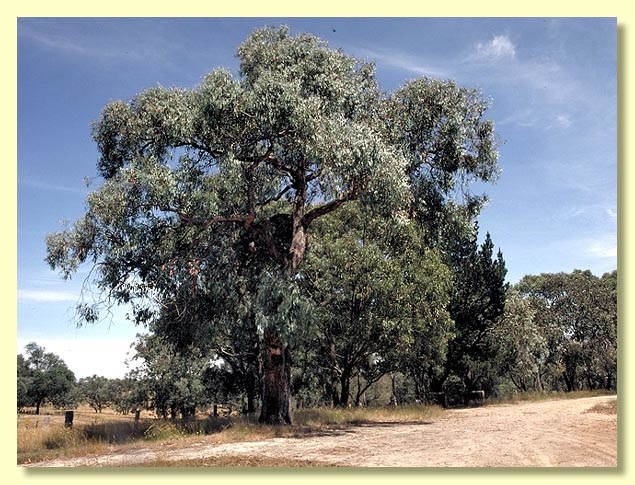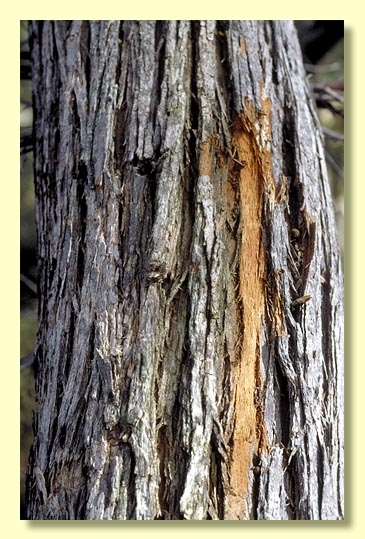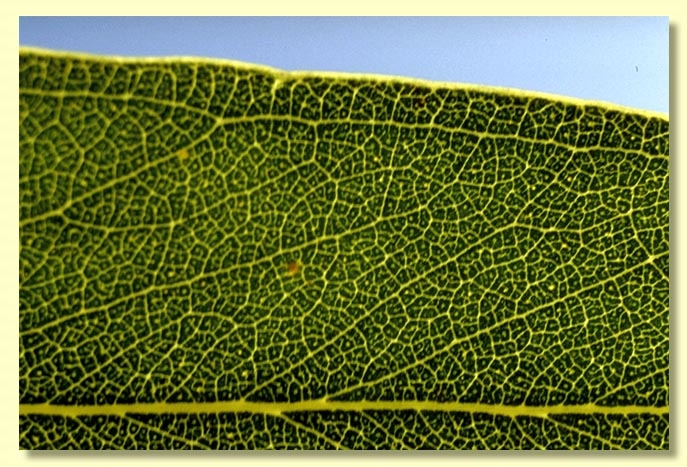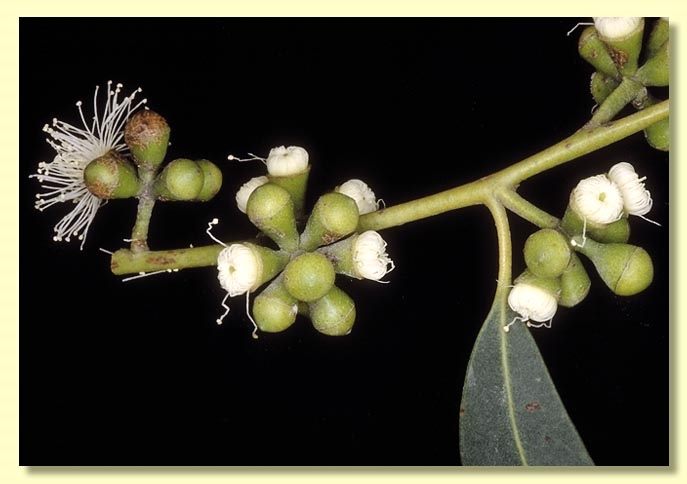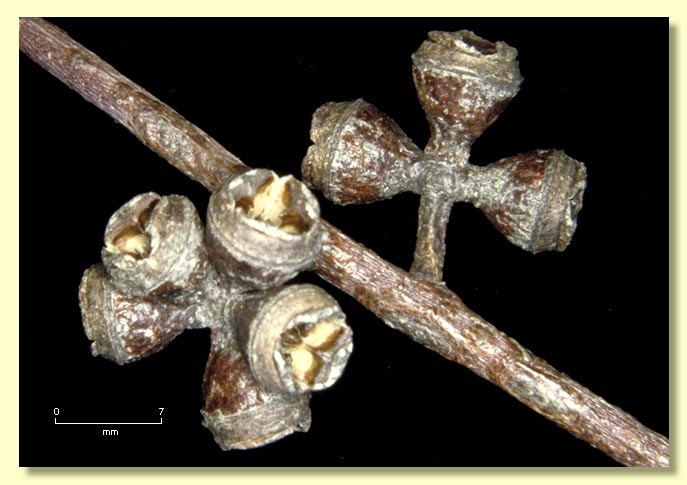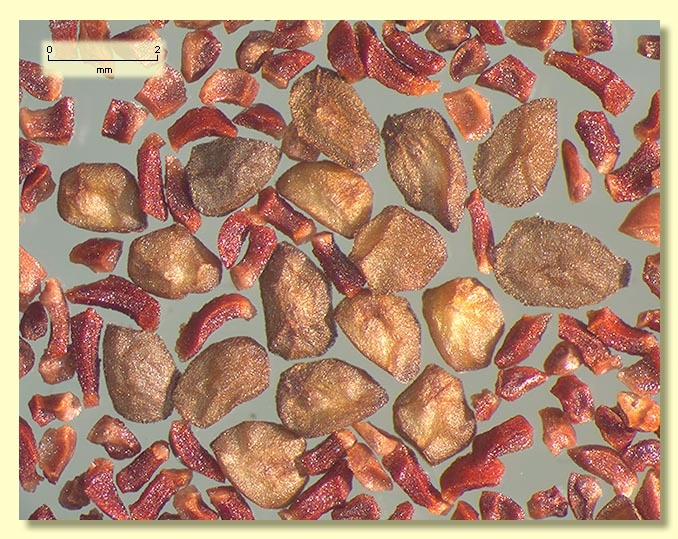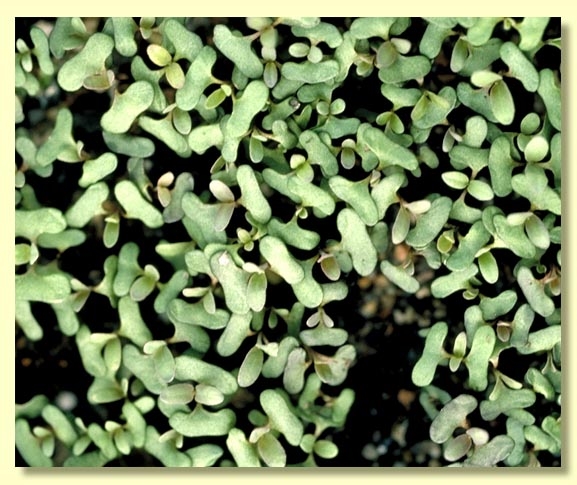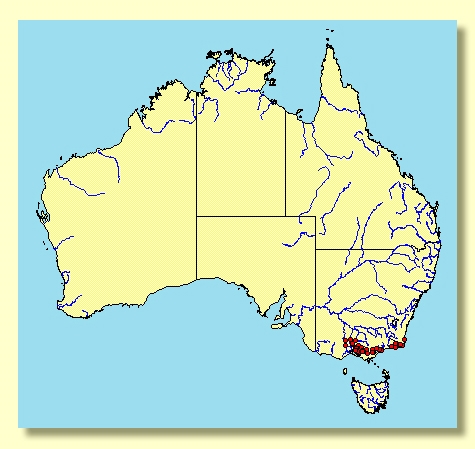Euclid - Online edition
Eucalyptus cephalocarpa
Eucalyptus | Symphyomyrtus | Maidenaria | Euryotae | Argyrophyllae
E. cinerea var. multiflora Maiden, Crit. Revis. Eucalyptus 3: 7 (1914). T: Dandenong Mts, Vic., June 1901, J.H.Maiden s.n.; lecto: NSW, fide W.F.Blakely, loc.cit.
Bark rough throughout, thick or the branches smooth; rough bark fibrous, longitudinally fissured, grey or grey-brown over red-brown, smooth bark pale brown to cream, branchlets often glaucous.
Juvenile growth (coppice or field seedlings to 50 cm): stem rounded in cross-section, usually glaucous; juvenile leaves opposite and sessile for many pairs, orbicular to ovate, 2.5–8.5 cm long, 1.7–6.5 cm wide, margin entire or crenulate, blue-green to glaucous or occasionally green.
Crown green, or silvery due to glaucous new tip growth.
Adult leaves alternate, petiole 0.6–2.2 cm long; blade lanceolate to falcate, 8.5–25 cm long, 0.8–3 cm wide, base tapering to petiole, concolorous, glossy or dull, green to blue-green, side-veins usually greater than 45° to midrib, sometimes acute, moderately to densely reticulate, intramarginal vein parallel to and just within margin or well removed from it, oil glands mostly island.
Inflorescence axillary unbranched, peduncles 0.4–1.8 cm long, buds 7 per umbel, sessile or on pedicels to 0.3 cm long. Mature buds clavate or diamond-shaped to ovoid, 0.3–0.6 cm long, 0.3–0.4 cm wide, green to yellow, scar present, operculum conical to rounded, rarely beaked, stamens inflexed, anthers cuboid to oblong, versatile, dorsifixed, dehiscing by longitudinal slits (non-confluent), style long, stigma blunt, locules 3 or 4, the placentae each with 4 vertical ovule rows. Flowers white.
Fruit sessile or on pedicels to 0.2 cm long, obconical, campanulate or hemispherical, 0.3–0.6 cm long, 0.4–0.8 cm wide, often glaucous, disc raised-convex or -oblique, valves 3 or 4, exserted or near rim level.
Seeds black, brown or grey, 1–2.5 mm long, ovoid or flattened-ovoid, often pointed at one end, lacunose, dorsal surface smooth or shallowly pitted, hilum ventral.
Cultivated seedlings (measured at ca node 10): cotyledons bilobed; stems rounded in cross-section, usually glaucous; leaves sessile, opposite for many nodes, orbicular to cordate, 1.2–5.5 cm long, 0.5–5 cm wide, base amplexicaul or rounded, margin sometimes subcrenulate, apex rounded or emarginate, glaucous or rarely green to grey-green.
Flowering has been recorded in February, March, April , May and June.
A small to medium-sized tree distributed in Victoria from Malmsbury, Kinglake and the Mornington Peninsula east to Mallacoota extending just into New South Wales in Nadgee Nature Reserve and East Boyd State Forest. On larger trees it has furrowed rough "stringy" bark, a crown of alternate petiolate lanceolate adult leaves, opposite sessile ovate glaucous juvenile leaves, and buds in axillary umbels of 7.
Eucalyptus cephalocarpa belongs in Eucalyptus subgenus Symphyomyrtus section Maidenaria, a large group of species more or less restricted to south-eastern Australia, characterised by bilobed cotyledons, simple axillary inflorescences, buds with two opercula, stamens with versatile anthers and flattened seeds with a ventral hilum. Within this section, E. cephalocarpa belongs in series Argyrophyllae having longitudinally furrowed fibrous rough bark throughout, orbicular or ovate juvenile leaves opposite for many nodes and small diamond-shaped buds in threes and sevens. There are five species in series Argyrophyllae: E. alligatrix (with 3 subspecies), E. cephalocarpa, E. cinerea (with 2 subspecies), E. conspicua, E. nova-anglica.
Of these species E. cephalocarpa, with its crown leaves fully adult (i.e. alternate, petiolate, lanceolate), could only be confusd with the coastal species E. conspicua with which it overlaps in the eastern part of its distribution. E. conspicua has a crown of very coarse-textured adult leaves and always some intermediate and juvenile leaves also (the latter leaf-types will tend to be broader, with shorter petioles and be placed opposite to subopposite on the stems). Confusingly in East Gippsland both species grow near swamps dominated by the sedge Ghania with E. conspicua always lower in the landscape than is E. cephalocarpa. The other species in series Argyrophyllae with an adult-leaved crown are E. alligatrix, which is distributed inland from the Great Dividing Range in Victoria and central New South Wales, and E. nova-anglica which is endemic to the Northern Tablelands of New South Wales. Both these species, like E. cephalocarpa, have buds in 7s. On the Southern Tablelands of New South Wales there is also E. cinerea subsp. triplex which develops some petiolate adult leaves in the crown but has buds in 3s.
Eucalyptus cephalocarpa has been confused in the field with E. ignorabilis, especially in far south-eastern New South Wales. The latter species is non-glaucous, has finely fibrous rough bark and lanceolate-elliptic juvenile leaves.

